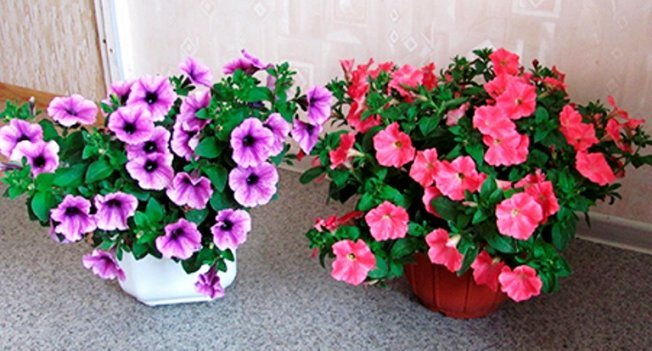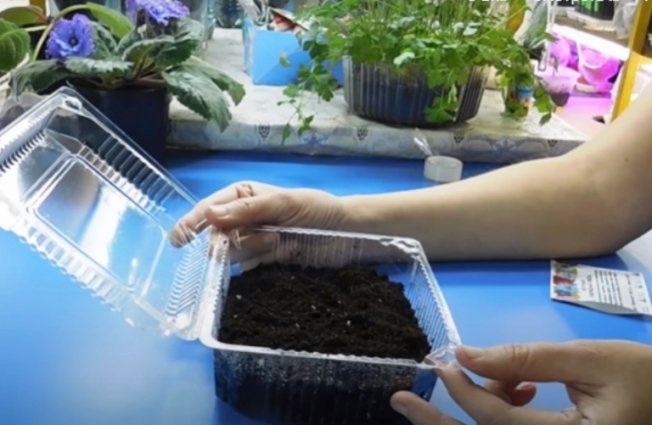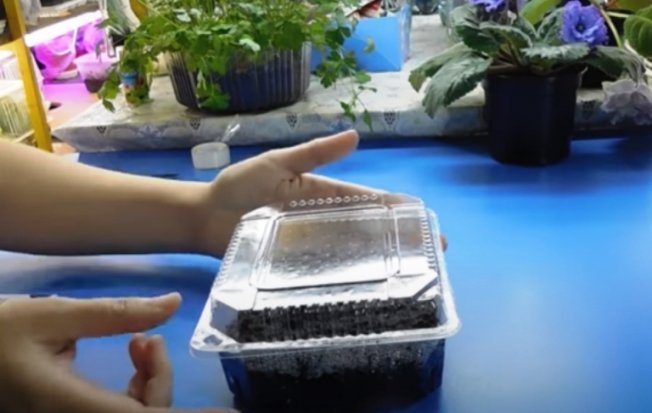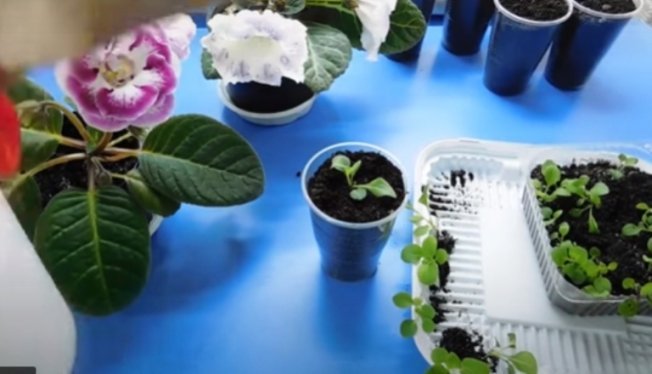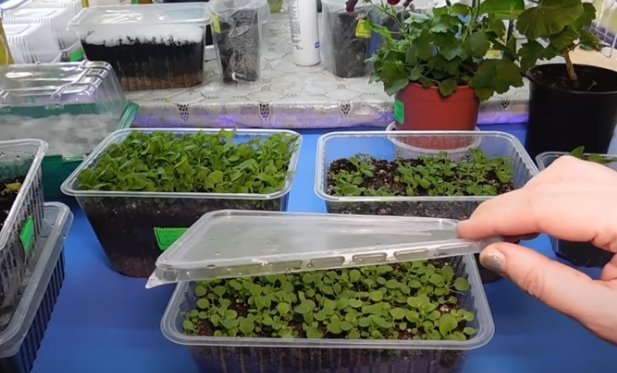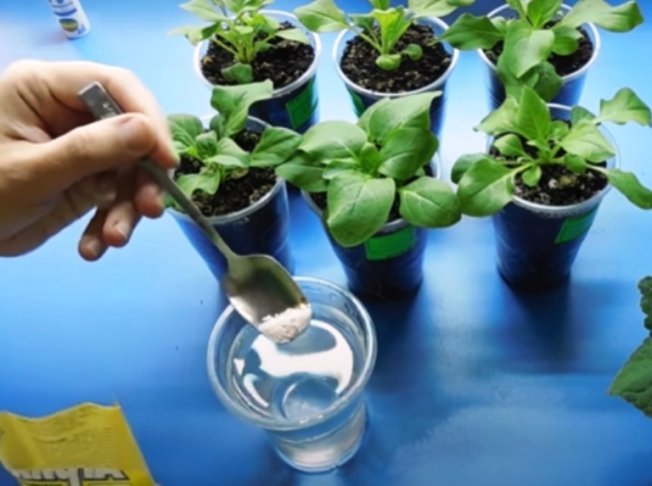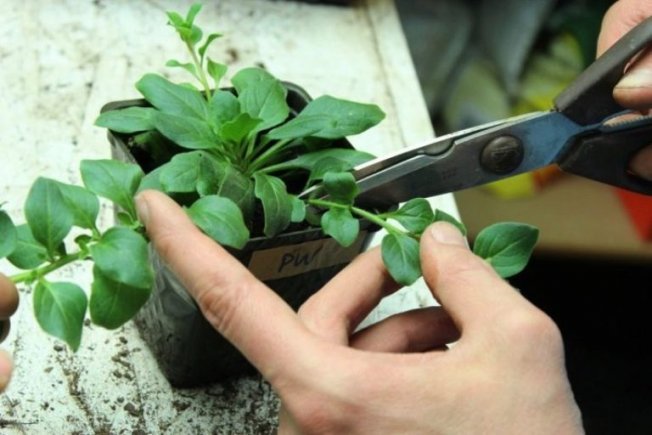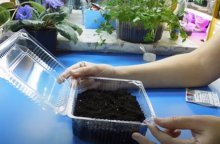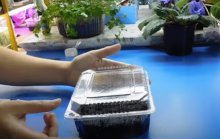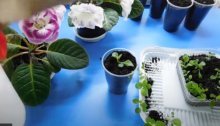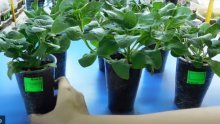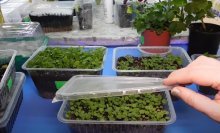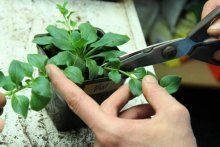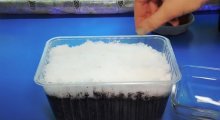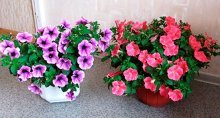How to properly grow petunia seedlings at home from seeds

This flower has no equal in beauty, duration of flowering and variety of forms. But its seedlings are not cheap on the market. Therefore, we will consider how to properly grow petunia seedlings at home from seeds, and learn the secrets of obtaining strong, healthy plants, prepared for life in the fresh air and active flowering.
Content:
- How to choose seeds
- Containers for petunia seedlings
- What soil to use
- How to sow correctly
- When to sow
- How to pick seedlings and when
- Proper care
- How to feed seedlings
- Growing seedlings with pinching without pinching
How to choose seeds
This question is more interesting for beginner gardeners who don’t yet have favorites. varieties of petunia. It should be taken into account that seeds of bush varieties are more suitable for growing in soil; they look lush and branch very actively. Ampelous varieties are planted in hanging boxes or baskets. You can plant them more densely; they branch reluctantly, even with systematic pinching.
Petunia seeds can be regular or coated. The latter are easier to sow, but their germination requires sufficient soil moisture; the shell will not dissolve in a dry environment. Coated seeds have strict shelf life, violation of which leads to loss of germination. It turns out.that ordinary seeds are more reliable, although difficulties may arise when sowing them due to their very small size.
There is some danger in buying a mixture of different varieties. The flowering of plants from such mixes does not always live up to expectations. It is better to choose specific varieties, then there will be a guarantee that the color scheme of your green spaces will correspond to the one you are counting on.
The purchase of seeds should be made only in stores, those that have proven themselves well; it is also better to take seeds from trusted manufacturers.
Even knowing how to grow petunia seedlings at home, you can fail due to poor seed germination.
When purchasing, it is better to choose seeds in bags with an inner layer of foil or plastic film: Such seeds do not lose their viability for 2 years. The shelf life of planting material in paper bags is only one year.
Containers for petunia seedlings
You can use food grade plastic boxes with lids as containers for seedlings - these are convenient ready-made mini greenhouses.
You can keep seedlings in them right up to picking: the containers are easily ventilated, the transparent lids will let in enough light for the growing plants.
What soil to use
The soil mixture for seedlings should have a neutral acidity level from pH 5.5 to 6.5. Soil acidification can lead to the development of chlorosis in young plants.
As for the composition, the soil mixture should include:
- humus;
- peat;
- river sand;
- perlite or vermiculite.
It is recommended to heat treat the soil by calcining it in the oven.
It makes sense to consider the method of sowing into a soil mixture with hydrogel.Soak it in a solution of fertilizers suitable for petunias, for example, Kemira. Seedlings gain access to the required amount of moisture and additional nutrients.
How to sow correctly
Petunia seeds are very small; they are laid out on the surface of the substrate and not sprinkled on top - otherwise they may not germinate. But it is quite difficult to sow very small seeds evenly.
Experienced flower growers advise using a moistened wooden toothpick: by picking up a seed with the tip, you can carefully transfer it to a container for seedlings and place it on the surface of the soil. You can also use toothpicks and mark the places where you place the seeds. To ensure contact of the seeds with the soil, they are slightly pressed to the surface.
There is an option to sow petunia seeds on snow; they are clearly visible on a white surface.
After placing the seeds on the surface, the substrate is sprayed with warm water from a spray bottle. Then the containers are covered with lids (polyethylene, glass). Condensation may accumulate on the lid. Therefore, crops are ventilated from time to time. It is also recommended to keep the soil moist; it should not dry out.
You should expect germination within 2 weeks; if sprouts have not appeared before this time, it means the seeds are of poor quality, even if they germinate later, the plants will be weak and will require more careful care.
When determining the number of seeds, it should be taken into account that petunia sprouts are very fragile; during the process of development and picking, the possibility of losses cannot be excluded. Those. It is advisable to sow more seeds than seedlings required.
Let's watch a video on how to properly sow petunia seeds:
When to sow
Calculate sowing dates preferably independently, based on the expected dates of planting in open ground. You should consider whether there are late spring frosts in the area where you live. On average, it will take from 2 to 2.5 months to develop a full-fledged plant ready for planting.
For the Middle Zone, the best time for sowing is the third ten days of February - early March. If you want to get earlier flowering, you can sow petunia seedlings earlier, but you will need to organize high-quality lighting, strictly control the temperature, and avoid the formation of drafts.
How to pick seedlings
Diving involves carefully transplanting seedlings into personal pots or plastic cups. It should be borne in mind that petunias have a branched and extensive root system. Since growing seedlings requires a relatively long time, at least 2 months, or even 3, as practice shows, you should think about the option of containers with a sufficient volume of soil. If the roots are in cramped conditions, then it will not be possible to get full-fledged seedlings.
If there are no conditions for placing large containers with seedlings, then transplantation into small glasses is practiced first. After about a month, the plants are transplanted into larger containers.
It may seem to some that there is too much fuss with a double transplant, but you should understand that the reward for your painstaking work will be excellent, strong seedlings with formed buds. The bushes easily tolerate transplantation into the ground and quickly adapt to new living conditions.
Picking is done after the first pair of true leaves appear, about a week after emergence.If there is enough space for the bushes to grow, then you can take your time with picking and postpone it for a while until the second pair of leaves appears.
When replanting, the stems are buried to the level of the cotyledon leaves; deeper planting threatens the plants to stretch and lie flat. Excessive deepening is also undesirable; plants may even die.
Proper care
It's time to learn how to properly grow petunia seedlings at home, i.e. Learn the secrets of producing healthy, attractive plants.
Let us clarify that petunias love good lighting, i.e. February crops will definitely need additional lighting. Lighting begins after the sprouts appear; in low light, the plants will stretch out.
Seedlings will need artificial lighting until about mid-May, but if the recommended temperature regime is maintained, then additional lighting can be minimized already at the end of April.
The second point is the temperature regime. The ideal option is to maintain the temperature within + 23 +25 C until germination. After the emergence of seedlings, it will be necessary to systematically ventilate the containers; the ventilation time must be increased gradually; too sudden temperature changes can destroy delicate plants. The greenhouses are ventilated 2-3 times a day; the cover can be completely removed if it interferes with the further growth of the bushes.
After picking, the strengthened seedlings continue to be hardened, for which the temperature is slowly reduced. It is recommended to maintain the daytime temperature at + 18 + 20 C, and the night temperature at +15 C.
Water the seedlings carefully, avoiding water getting on the leaves.Watering is carried out as the soil in the containers dries out; petunia does not tolerate excessive soil moisture and suffers from insufficient moisture. In addition, high soil moisture can lead to rot.
The ideal option is to organize drip irrigation, which ensures moderate soil moisture.
For detailed information about growing petunia, watch a useful video:
How to feed seedlings
Petunia develops quickly, so it is recommended to feed the seedlings. If soil with the addition of hydrogel was used during planting, then the need for fertilizing will come later and will need to be done less often. For fertilizing, you can use complex fertilizers, which you usually use for flowers.
But it is more correct to apply phosphorus-containing fertilizers 10 days after picking: they promote the development of the root system. After the next 10-14 days, nitrogen fertilizing is carried out. Next, you can fertilize with potassium fertilizers, or with special, complex fertilizers. Fertilizers can be applied once every two weeks, or every 3-4 days, while proportionally reducing the dose (by 3-4 times).
If there is a suspicion that the growth points are dying, you can apply boric acid.
Growing seedlings with pinching without pinching
It is advisable to pinch only bush varieties; hanging varieties will in any case grow in length, the formation of lateral shoots will be weak. You should not get carried away with pinching; too frequent a procedure delays the onset of flowering.
Pinching is done with fingers or nail scissors. It consists of removing the top of the shoots, literally two developed leaves.The cut should be made closer to the outermost leaf on the branch. The cutting line should not go across the stem, but slightly obliquely. After the procedure, the plant actively gains green mass due to the appearance of new shoots. During this period, it should be fed with a complex fertilizer containing nitrogen.
You can try to root the cut tops; to do this, the branch is immersed with the cut in the ground and cared for like a pruned seedling.
The peculiarity of modern hybrids is that they do not require pinching and bush on their own. Don’t be upset if the shoots stretch out: after planting in the ground, they will definitely get their way.
Growing without pinching, even ordinary varieties, has some advantages: plants without numerous side shoots take root better when transplanted. In flower beds, such bushes develop rapidly, bloom actively, and their flowering period is longer: they saved a lot of energy in the first stage of their life.
Let's watch a useful video about pinching petunias:
If all the recommendations for growing and sowing dates are followed, then in the second ten days of May the seedlings will be ready for planting in flower beds or in pots located outside, of course, if weather conditions permit.
Knowing how to properly grow petunia seedlings at home, you can get excellent garden plants with early flowering. But to admire the lush blooms, you still need knowledge, care skills and accuracy.

